John Allore's Blog, page 12
March 19, 2021
Quebec suffers from the twin diseases of Nostalgia and Amnesia
When the time is right, I’ll tell you what happened to Dorion and Tremblay. Not now. I need a break from the 1970s.
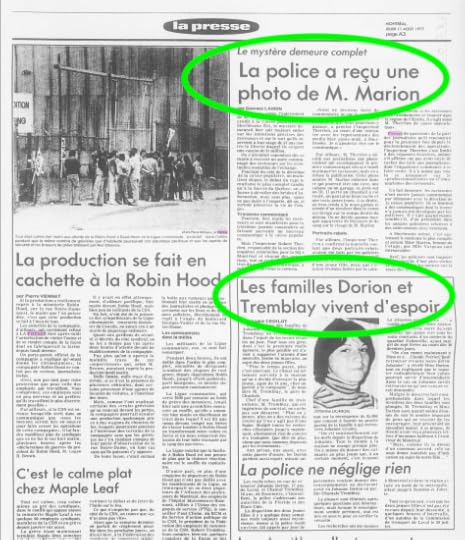 The post Quebec suffers from the twin diseases of Nostalgia and Amnesia first appeared on WHO KILLED THERESA?.
The post Quebec suffers from the twin diseases of Nostalgia and Amnesia first appeared on WHO KILLED THERESA?.
March 13, 2021
F.L. FRENCHY I LOVE YOU – Teresa Martin #2 / WKT5
PREVIOUS PODCAST: Pattern Recognition – Teresa Martin / WKT5 #1
NEXT PODCAST: Le Sadique Meurtrier -Teresa Martin / WKT5 #3
Teresa Martin was meant to be found like that – displayed against the wall of that tavern on a Saturday morning, for families to see the ambulance and the squad cars as they drove on their way to hockey practice or garden centres, so it would be the topic of conversation all that weekend, and into Monday morning for the local boys and girls going to school. That’s certain.
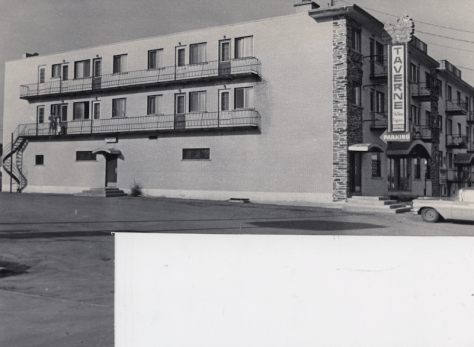 Taverne du Vieux Cypres / Archives Madame KarineTeresa Martin: What the public knew / What the public has forgotten
Taverne du Vieux Cypres / Archives Madame KarineTeresa Martin: What the public knew / What the public has forgottenOn Monday morning, September 15, 1969, The Montreal Gazette reported that 14-year-old Theresa Martin was found unconscious on a sidewalk by a passing bystander in Montreal North. The bystander tried to question her, but found her unresponsive. Rushed by ambulance to the Sacre Coeur hospital, she was pronounced dead on arrival. According to further reporting by The Gazette, the autopsy confirmed she was not “sexually molested but her body was mutilated by her assailant.” Carved on her abdomen with a knife or needle was a tattoo reading, “F.V. French I Love You.” The cause of death was determined to be “suffocation”. According to The Gazette, she had a bruised lip and had been “struck twice behind the head with a blunt instrument.” At the time police were still looking for Theresa Martin’s “shoes, earrings, and scarf which had been removed from her body.” On the one year anniversary of her death, The Gazette ran a recap story of the Martin murder but this time the “crude inscription” was noted as reading, “F.L. Frenchy I Love You.”
The French language newspaper, La Presse also ran a story on September 15, 1969, but with more details of the murder. Andre Beauvais reported that Theresa Martin lived at 6380 rue Levis in Montreal North, about a 1/2 from where she was found. Martin was 14-years-old (in some versions she is 13 or 15), and she was found by the bystander around 3:30 in the morning in a “seated position” against the wall of the Vieux Cypres taverne at 6715 boulevard Henri-Bourassa. She was without shoes and had marks of violence on her face. This reporter stated that the tattoo read, “Frenchy, I love you”, accompanied by the initials, “F.V.”. In addition to the missing shoes, earrings and glasses, Martin didn’t have any identification papers in her possession ( wallet. purse, etc…). The article suggests the tattoo was made simultaneously with her murder.
According to La Presse, Martin left her home on Friday evening, September 12 to go to the movies with friends. She was last seen around midnight. The police spent the weekend interviewing several of Martin’s friends and her parents. Her mother and father told the police to their knowledge Theresa didn’t frequent the company of bikers, who might engage in tattoo rituals. Montreal North Police Sergant Gilbert Dorion stated, “This was a young girl from a good family… She was an adolescent who was very physically developed for her age.” The paper suggested that maybe “F.V.” were the initials of the “sexual maniac” that attacked her.
By the end of September, Michel Auger of La Presse reported that a reward was being offered for information that would assist in solving the murder of Theresa Martin. Police had six officers working the case. During the autopsy, Dr. Jean Hould surmised that someone might have held their hand over Martin’s mouth to prevent her from screaming, thereby asphyxiated her. In this iteration of the story the tattoo is said to have been inscribed, “Frenchie, I love you, F.V.” in “big letters across her belly”. Auger asks the question, “Is this a sinister maniac who wants to leave his signature on his crime, or a clever murderer who wants to send the police down the wrong path?” For the first time we are told that the sunglasses she was wearing that night were missing. Further, there were no indications of drugs or alcohol in her system, and police again insisted Martin did not associate herself with motorcycle gangs.
The French daily Montreal Matin spent most of their reporting focusing on the tattoo ( though they unfortunately publish the message as, “F.V. French I Love You!”, with an exclamation point within quotations). They suggest that the “F.V.” of the tattoo may be the initials of the inscriber, and that, “they may have been involved in the affair.” It’s also worth noting here that both Montreal Matin and La Presse state that doctor Jean-Paul Valcourt of the crime medical laboratory concluded that the tattoo had been carved at least two weeks prior to her death, as the scars were not fresh but had not yet healed. These reports later turned out to be false, the confusion caused by the manner of the tattoo – the cuts were not deep like a traditional tattoo and therefore did not require time to heal, meaning they were done fast and improvised.
Photo Police gives us yet another version of the tattoo inscription reporting it was. “”I love you french” avec les initiales V.L.” that was inscribed, and stating that police are pondering whether this is the mark of a sadistic individual, or from a band of bikers. The article says the marking is “very recent” and “may have been made after her death.” They also publish a photo of M. Cyr standing next to the tavern wall.
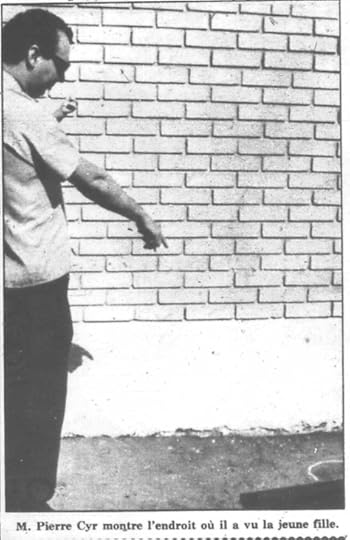 M. Pierre Cyr who lived above the tavern where Teresa Martin was found
M. Pierre Cyr who lived above the tavern where Teresa Martin was foundUp to this point, the reporting is what you’d expect. Inconsistent, missing some facts and detail, but that’s what you’d expect when the journalists are at the mercy of what the police are feeding them. Then the Journal De Montreal takes a vastly different tact and begins with a full-court-press approach of victim blaming. The byline in their September 15th article is, “Victime de la drogue?” The Journal De Montreal spends an entire paragraph on a drug theory which includes the damning statement, “A rumor persists that the young girl succumbed from a large ingestion of drugs”, a rumor which could only have been started, here, in the September 15th edition of the Journal de Montreal, as this was the first day of any reporting on the matter. They go on, “However the father did not make any statement that could link his daughter’s death to drugs.” What father could?
In the days that followed, the Journal De Montreal would not let up with their “drug theory”. They restate it in a September 16th piece, and then double-down on their malicious and false reporting:
“The thing that is certain, the young Montreal North resident was not murdered; the autopsy will prove that right away. Most likely, she was encouraged by her companions to take drugs and this resulted in her death.”
Journal de Montreal, September 16, 1969, Page 4.
After the autopsy is performed and it is proven conclusively that there were no drugs or alcohol in Teresa Martin’s system does the Journal de Montreal clarify and apologize for their errors? No, they simply never report on the case again. If all of this sounds vaguely familiar, it is exactly what the JdM did in my sister Theresa’s case nearly a decade later. You can read all about that over at this post ( click the link).
On Sunday, September 21, 1969 The Quebec tabloid, Allo Police runs a full-page story on the Theresa Martin murder, and it is here we see more complete details on the case. Theresa leaves her parents’ home that Friday evening for a night at the movies, accompanied by “two young people”. When she fails to return home, her father reports her missing to the police. It is then her father who makes the identification early that morning at the Montreal morgue on rue Parthenais. Allo describes the words inscribed on her abdomen as, “F.V. Frenchie I love you”, and states it was impossible to determine if the cutting occurred before or after the murder. Occurring after the murder seems improbable as the bystander stated she was alive at the time he found her, and died in the ambulance on the way to the hospital. Again we are told that Theresa Martin didn’t have any connections with bikers, and therefore these marks could not have been part of some initiation ritual, known to occur in the biker milieu or in the world of “beatniks”. Allo Police ends their story stating the drama that has unfolded in Montreal North is a “complete mystery”.
In October Allo Police runs a two-page feature on Teresa Martin – by this time she is referred to by the French spelling of the name – in which it is revealed that her father has hired a private investigator to assist in solving the crime. In this article we are told police now think she may have been suffocated by having a plastic bag pulled over her head, and that the blows to the back of her skull may have been caused when she was placed up against the wall in the parking lot of the Tavern Vieux Cypres. The bystander who discovered her was a M. Pierre Cyr, who resided in an apartment above the Taverne Vieux Cypres. She appeared to him to be asleep, but when he tried to speak to her she was unresponsive. The tattoo is described as, “F.V. Frenchy I love you”. This time Allo Police definitively states that the tattoo was made after the murder, which one can surmise means that M. Cyr was mistaken when he thought she was alive – though why an ambulance would have been called is anybody’s guess.
In this article we begin to get a little more detail about Teresa’s home life. We are told she was a very ordered girl, from a very regular family. Her mother was the headmistress / directrice of a private school. Teresa attended the private school, the “convent” College Regina Sancta / Regina Assumpta. Theresa is described as a “brilliant student”. We are also told that Theresa was fluently bilingual, a good girl, and was never seen in the realm of bikers. The article confirms there were no traces of alcohol or drugs in her system.
Her closest friend was a 12-year-old girl named Sylvie Perron whose father, Maurice had a country ranch called Bonanza on the island of Laval. Maurice considered Teresa like his own daughter, and the two girls would spend weekends at the ranch, camping and riding horses. Teresa and Sylvie were planning a summer trip to Florida. Sylvie described Teresa as very exceptional in her habits.
On the night of her disappearance, Teresa obtained special permission from her parents to travel to the Galeries d’Ajou mall with two friends. Allo Police states that the the film they chose to see was “Jeux Pervers”. At the end of the evening she got on bus 41 bound for the intersection of boulevards Leger and Lacordaire in the vicinity of her neighborhood. A bus driver later questioned stated that he saw her disembark from his bus later that evening at the corners of boulevards Gouin and Rolland, about a two block walk from her Leger apartment building. It is here that we lose her trail. There is no sighting of Teresa after she leaves the bus until M. Cyr discovers her under four hours later against the wall of the Taverne Vieux Cypres.
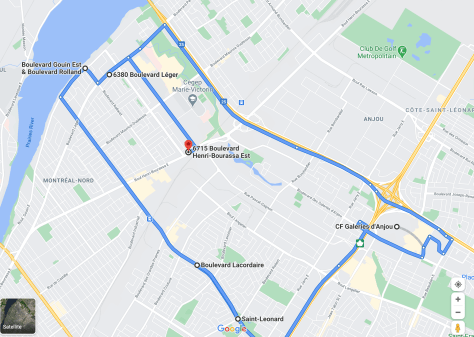 This map is just a representation of the locations, not of a suggested route.
This map is just a representation of the locations, not of a suggested route.WHAT IS GOING ON HERE? For an analysis of the media reporting, please listen to the podcast.
The post F.L. FRENCHY I LOVE YOU – Teresa Martin #2 / WKT5 first appeared on WHO KILLED THERESA?.F.L. FRENCHY I LOVE YOU – Teresa Martin / WKT5 #2
Teresa Martin was meant to be found like that – displayed against the wall of that tavern on a Saturday morning, for families to see the ambulance and the squad cars as they drove on their way to hockey practice or garden centres, so it would be the topic of conversation all that weekend, and into Monday morning for the local boys and girls going to school. That’s certain.
 Taverne du Vieux Cypres / Archives Madame KarineTeresa Martin: What the public knew / What the public has forgotten
Taverne du Vieux Cypres / Archives Madame KarineTeresa Martin: What the public knew / What the public has forgottenOn Monday morning, September 15, 1969, The Montreal Gazette reported that 14-year-old Theresa Martin was found unconscious on a sidewalk by a passing bystander in Montreal North. The bystander tried to question her, but found her unresponsive. Rushed by ambulance to the Sacre Coeur hospital, she was pronounced dead on arrival. According to further reporting by The Gazette, the autopsy confirmed she was not “sexually molested but her body was mutilated by her assailant.” Carved on her abdomen with a knife or needle was a tattoo reading, “F.V. French I Love You.” The cause of death was determined to be “suffocation”. According to The Gazette, she had a bruised lip and had been “struck twice behind the head with a blunt instrument.” At the time police were still looking for Theresa Martin’s “shoes, earrings, and scarf which had been removed from her body.” On the one year anniversary of her death, The Gazette ran a recap story of the Martin murder but this time the “crude inscription” was noted as reading, “F.L. Frenchy I Love You.”
The French language newspaper, La Presse also ran a story on September 15, 1969, but with more details of the murder. Andre Beauvais reported that Theresa Martin lived at 6380 rue Levis in Montreal North, about a 1/2 from where she was found. Martin was 14-years-old (in some versions she is 13 or 15), and she was found by the bystander around 3:30 in the morning in a “seated position” against the wall of the Vieux Cypres taverne at 6715 boulevard Henri-Bourassa. She was without shoes and had marks of violence on her face. This reporter stated that the tattoo read, “Frenchy, I love you”, accompanied by the initials, “F.V.”. In addition to the missing shoes, earrings and glasses, Martin didn’t have any identification papers in her possession ( wallet. purse, etc…). The article suggests the tattoo was made simultaneously with her murder.
According to La Presse, Martin left her home on Friday evening, September 12 to go to the movies with friends. She was last seen around midnight. The police spent the weekend interviewing several of Martin’s friends and her parents. Her mother and father told the police to their knowledge Theresa didn’t frequent the company of bikers, who might engage in tattoo rituals. Montreal North Police Sergant Gilbert Dorion stated, “This was a young girl from a good family… She was an adolescent who was very physically developed for her age.” The paper suggested that maybe “F.V.” were the initials of the “sexual maniac” that attacked her.
By the end of September, Michel Auger of La Presse reported that a reward was being offered for information that would assist in solving the murder of Theresa Martin. Police had six officers working the case. During the autopsy, Dr. Jean Hould surmised that someone might have held their hand over Martin’s mouth to prevent her from screaming, thereby asphyxiated her. In this iteration of the story the tattoo is said to have been inscribed, “Frenchie, I love you, F.V.” in “big letters across her belly”. Auger asks the question, “Is this a sinister maniac who wants to leave his signature on his crime, or a clever murderer who wants to send the police down the wrong path?” For the first time we are told that the sunglasses she was wearing that night were missing. Further, there were no indications of drugs or alcohol in her system, and police again insisted Martin did not associate herself with motorcycle gangs.
The French daily Montreal Matin spent most of their reporting focusing on the tattoo ( though they unfortunately publish the message as, “F.V. French I Love You!”, with an exclamation point within quotations). They suggest that the “F.V.” of the tattoo may be the initials of the inscriber, and that, “they may have been involved in the affair.” It’s also worth noting here that both Montreal Matin and La Presse state that doctor Jean-Paul Valcourt of the crime medical laboratory concluded that the tattoo had been carved at least two weeks prior to her death, as the scars were not fresh but had not yet healed. These reports later turned out to be false, the confusion caused by the manner of the tattoo – the cuts were not deep like a traditional tattoo and therefore did not require time to heal, meaning they were done fast and improvised.
Photo Police gives us yet another version of the tattoo inscription reporting it was. “”I love you french” avec les initiales V.L.” that was inscribed, and stating that police are pondering whether this is the mark of a sadistic individual, or from a band of bikers. The article says the marking is “very recent” and “may have been made after her death.” They also publish a photo of M. Cyr standing next to the tavern wall.
 M. Pierre Cyr who lived above the tavern where Teresa Martin was found
M. Pierre Cyr who lived above the tavern where Teresa Martin was foundUp to this point, the reporting is what you’d expect. Inconsistent, missing some facts and detail, but that’s what you’d expect when the journalists are at the mercy of what the police are feeding them. Then the Journal De Montreal takes a vastly different tact and begins with a full-court-press approach of victim blaming. The byline in their September 15th article is, “Victime de la drogue?” The Journal De Montreal spends an entire paragraph on a drug theory which includes the damning statement, “A rumor persists that the young girl succumbed from a large ingestion of drugs”, a rumor which could only have been started, here, in the September 15th edition of the Journal de Montreal, as this was the first day of any reporting on the matter. They go on, “However the father did not make any statement that could link his daughter’s death to drugs.” What father could?
In the days that followed, the Journal De Montreal would not let up with their “drug theory”. They restate it in a September 16th piece, and then double-down on their malicious and false reporting:
“The thing that is certain, the young Montreal North resident was not murdered; the autopsy will prove that right away. Most likely, she was encouraged by her companions to take drugs and this resulted in her death.”
Journal de Montreal, September 16, 1969, Page 4.
After the autopsy is performed and it is proven conclusively that there were no drugs or alcohol in Teresa Martin’s system does the Journal de Montreal clarify and apologize for their errors? No, they simply never report on the case again. If all of this sounds vaguely familiar, it is exactly what the JdM did in my sister Theresa’s case nearly a decade later. You can read all about that over at this post ( click the link).
On Sunday, September 21, 1969 The Quebec tabloid, Allo Police runs a full-page story on the Theresa Martin murder, and it is here we see more complete details on the case. Theresa leaves her parents’ home that Friday evening for a night at the movies, accompanied by “two young people”. When she fails to return home, her father reports her missing to the police. It is then her father who makes the identification early that morning at the Montreal morgue on rue Parthenais. Allo describes the words inscribed on her abdomen as, “F.V. Frenchie I love you”, and states it was impossible to determine if the cutting occurred before or after the murder. Occurring after the murder seems improbable as the bystander stated she was alive at the time he found her, and died in the ambulance on the way to the hospital. Again we are told that Theresa Martin didn’t have any connections with bikers, and therefore these marks could not have been part of some initiation ritual, known to occur in the biker milieu or in the world of “beatniks”. Allo Police ends their story stating the drama that has unfolded in Montreal North is a “complete mystery”.
In October Allo Police runs a two-page feature on Teresa Martin – by this time she is referred to by the French spelling of the name – in which it is revealed that her father has hired a private investigator to assist in solving the crime. In this article we are told police now think she may have been suffocated by having a plastic bag pulled over her head, and that the blows to the back of her skull may have been caused when she was placed up against the wall in the parking lot of the Tavern Vieux Cypres. The bystander who discovered her was a M. Pierre Cyr, who resided in an apartment above the Taverne Vieux Cypres. She appeared to him to be asleep, but when he tried to speak to her she was unresponsive. The tattoo is described as, “F.V. Frenchy I love you”. This time Allo Police definitively states that the tattoo was made after the murder, which one can surmise means that M. Cyr was mistaken when he thought she was alive – though why an ambulance would have been called is anybody’s guess.
In this article we begin to get a little more detail about Teresa’s home life. We are told she was a very ordered girl, from a very regular family. Her mother was the headmistress / directrice of a private school, the “convent” Regina Sancta. Theresa is described as a “brilliant student”. We are also told that Theresa was fluently bilingual, a good girl, and was never seen in the realm of bikers. The article confirms there were no traces of alcohol or drugs in her system.
Her closest friend was a 12-year-old girl named Sylvie Perron whose father, Maurice had a country ranch called Bonanza on the island of Laval. Maurice considered Teresa like his own daughter, and the two girls would spend weekends at the ranch, camping and riding horses. Teresa and Sylvie were planning a summer trip to Florida. Sylvie described Teresa as very exceptional in her habits.
On the night of her disappearance, Teresa obtained special permission from her parents to travel to the Galeries d’Ajou mall with two friends. Allo Police states that the the film they chose to see was “Jeux Pervers”. At the end of the evening she got on bus 41 bound for the intersection of boulevards Leger and Lacordaire in the vicinity of her neighborhood. A bus driver later questioned stated that he saw her disembark from his bus later that evening at the corners of boulevards Gouin and Rolland, about a two block walk from her Leger apartment building. It is here that we lose her trail. There is no sighting of Teresa after she leaves the bus until M. Cyr discovers her under four hours later against the wall of the Taverne Vieux Cypres.
 This map is just a representation of the locations, not of a suggested route.
This map is just a representation of the locations, not of a suggested route.WHAT IS GOING ON HERE? For an analysis of the media reporting, please listen to the podcast.
The post F.L. FRENCHY I LOVE YOU – Teresa Martin / WKT5 #2 first appeared on WHO KILLED THERESA?.February 27, 2021
Pattern Recognition – Teresa Martin #1 / WKT5
NEXT PODCAST: F.L. FRENCHY I LOVE YOU – Teresa Martin / WKT5 #2
I pitch this story. Call it Story A / The Lid. And these guys say, are you sure it’s a book, because it sounds like a podcast? Well it could be, It could be a podcast… and a book. But I’ll tell you something, if you want a podcast, I have a story for a podcast. So I pitch Story B, call it The Device. I say, what’s cool about this idea is that it has elements of Story A. Chronologically it comes after Story A, but I would be telling Story B first. So these elements would foreshadow what would be coming in the book – This is the podcast I was 24 hours away from recording here this weekend, the story I was going to tell over 12 episodes, an entire season, practically a whole year with just one story. And the guy goes… are you sure that’s a podcast? Because that sounds like a really good book. I like that book better than the first book.
So – Story C. This is Who Killed Theresa.
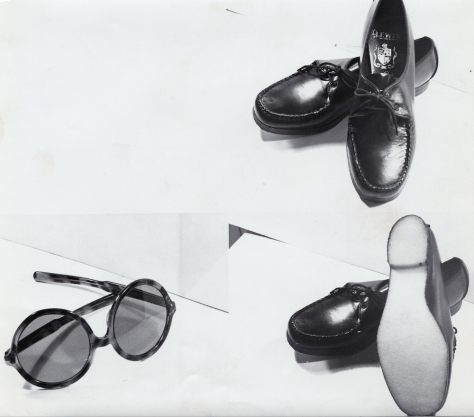 Sunglasses and shoes described as similar to the ones Teresa Martin was wearing when she disappeared in 1969 / Archives Madame Karine
Sunglasses and shoes described as similar to the ones Teresa Martin was wearing when she disappeared in 1969 / Archives Madame KarineStory C was research. It would probably end up as two paragraphs in Story A, The Lid. It also has elements that reflect, foreshadow, comment… And I am in no hurry to tell this story. I have a lot of information on this case, but I haven’t quite figured out how to land the plane. I haven’t completely worked out the staging. It has all the elements that you’re accustomed to hearing on WTK – set in Quebec, unsolved murder, criminal investigative failures. Quebec lives in this echo chamber of delusion. If you think the fake-news era in the States is bad, Quebec has been living in a version of this landscape ever since Champlain planted a fleur-de-lis on The Mountain. What strikes me about this case is how the narrative has changed over the last 50 years. There is now a very controlled version of this story, and most of the elements that would help solve the case have been dropped. I don’t buy the versions of this story peddled by the police and the press.
This is the 1969 unsolved murder of Teresa Martin.
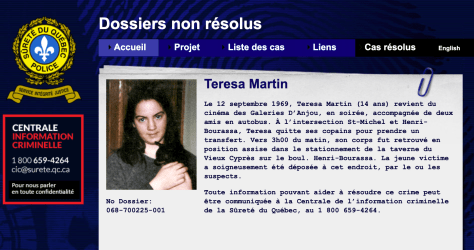 Surete Quebec notification of the Teresa Martin caseThe Airstream Trailer
Surete Quebec notification of the Teresa Martin caseThe Airstream Trailer Woods
Woods Door
Door CaravanThe Magus (1968) Original TrailerThe post Pattern Recognition – Teresa Martin #1 / WKT5 first appeared on WHO KILLED THERESA?.
CaravanThe Magus (1968) Original TrailerThe post Pattern Recognition – Teresa Martin #1 / WKT5 first appeared on WHO KILLED THERESA?.
Pattern Recognition – Teresa Martin / WKT5 #1
I pitch this story. Call it Story A / The Lid. And these guys say, are you sure it’s a book, because it sounds like a podcast? Well it could be, It could be a podcast… and a book. But I’ll tell you something, if you want a podcast, I have a story for a podcast. So I pitch Story B, call it The Device. I say, what’s cool about this idea is that it has elements of Story A. Chronologically it comes after Story A, but I would be telling Story B first. So these elements would foreshadow what would be coming in the book – This is the podcast I was 24 hours away from recording here this weekend, the story I was going to tell over 12 episodes, an entire season, practically a whole year with just one story. And the guy goes… are you sure that’s a podcast? Because that sounds like a really good book. I like that book better than the first book.
So – Story C. This is Who Killed Theresa.
 Sunglasses and shoes described as similar to the ones Teresa Martin was wearing when she disappeared in 1969 / Archives Madame Karine
Sunglasses and shoes described as similar to the ones Teresa Martin was wearing when she disappeared in 1969 / Archives Madame KarineStory C was research. It would probably end up as two paragraphs in Story A, The Lid. It also has elements that reflect, foreshadow, comment… And I am in no hurry to tell this story. I have a lot of information on this case, but I haven’t quite figured out how to land the plane. I haven’t completely worked out the staging. It has all the elements that you’re accustomed to hearing on WTK – set in Quebec, unsolved murder, criminal investigative failures. Quebec lives in this echo chamber of delusion. If you think the fake-news era in the States is bad, Quebec has been living in a version of this landscape ever since Champlain planted a fleur-de-lis on The Mountain. What strikes me about this case is how the narrative has changed over the last 50 years. There is now a very controlled version of this story, and most of the elements that would help solve the case have been dropped. I don’t buy the versions of this story peddled by the police and the press.
This is the 1969 unsolved murder of Teresa Martin.
 Surete Quebec notification of the Teresa Martin caseThe Airstream Trailer
Surete Quebec notification of the Teresa Martin caseThe Airstream Trailer Woods
Woods Door
Door CaravanThe Magus (1968) Original TrailerThe post Pattern Recognition – Teresa Martin / WKT5 #1 first appeared on WHO KILLED THERESA?.
CaravanThe Magus (1968) Original TrailerThe post Pattern Recognition – Teresa Martin / WKT5 #1 first appeared on WHO KILLED THERESA?.
January 29, 2021
When She Was Bad – The Patricia Pearson Interview / WKT4 #19
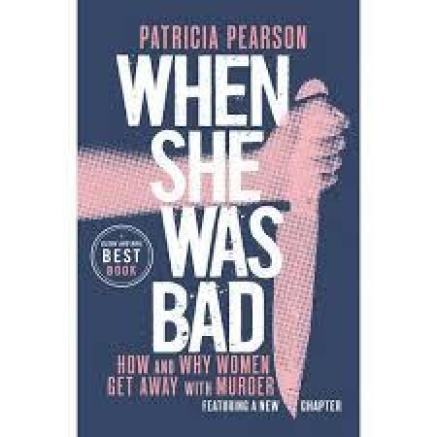 When She Was Bad
When She Was BadAn interview with author Patricia Pearson, her first book, When She Was Bad – How And Why Women Get Away With Murder was just re-released from Penguin Random House.
We discuss the the book, true crime, Karla Homolka, Bill James’ The Man From The Train, and the “Angel of Death”, nursing home caregiver and serial killer, Elizabeth Wettlaufer.
The post When She Was Bad – The Patricia Pearson Interview / WKT4 #19 first appeared on WHO KILLED THERESA?.January 13, 2021
Ian Thomas Caterill is dead
 Ian Caterill
Ian CaterillIan Caterill was the subject of much discussion in the editing of Wish You Were Here. Eventually we took his name out of the book at the advice of the publisher’s lawyers (this particular lawyer had successfully defended a challenge from Conrad Black, so I was not going to ignore his advice).
Except when I did ignore it. He also said I couldn’t accuse Roch Gaudreault of being a dirty cop, I said, “Yes I can, it was on the front page of the newspaper that he fabricated witness testimonies!”
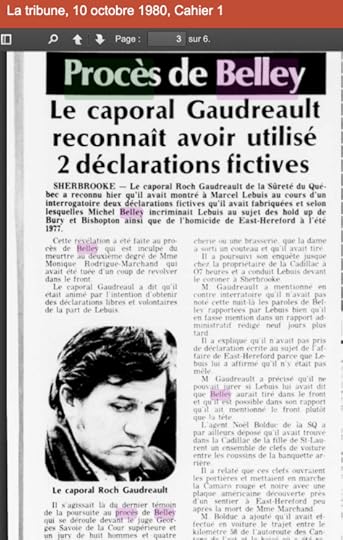 Roch Gaudreault
Roch GaudreaultIan Caterill was Gaudreault’s chief suspect in the death of my sister. The ring leader, in fact, in Gaudreault’s theory of “adolescent conspirators” and a drug overdose. Because he was Gaudreault’s chief suspect he became my father’s suspect. I never saw Ian as capable of such a thing, and anyway, there wasn’t any evidence – but that’s a long story, read Wish You Were Here.
 Wish You Were Here
Wish You Were HereStill, there were always questions surrounding Caterill that never got answered. As his obituary documents, he ended up on Gabriola Island, B.C., North of Victoria and Vancouver Island. One of the reasons we mentioned Luc Gregoire’s 1985 arrest in Saanich, B.C. – also on Vancouver Island – was to open the door for the possibility that Gregoire and Caterill knew each other, maybe having met in the low -evel drug trade in the Sherbrooke area in the late ’70s.
More unanswered questions. Ian died of a heart attack on October 6th, 2020 exactly two weeks after Wish You Were Here was published.
The post Ian Thomas Caterill is dead first appeared on WHO KILLED THERESA?.January 5, 2021
La quête d’une vie après un meurtre impuni
 PHOTO OLIVIER PONTBRIAND, ARCHIVES LA PRESSE
PHOTO OLIVIER PONTBRIAND, ARCHIVES LA PRESSEJohn Allore signe Wish You Were Here – A Murdered Girl, a Brother’s Quest and the Hunt for a Serial Killer, coécrit avec la journaliste et auteure canadienne Patricia Pearson.
À 14 ans, John Allore a perdu sa sœur Theresa, tuée par un inconnu dans les Cantons-de-l’Est, une histoire qu’il raconte dans son nouveau livre Wish You Were Here
Publié le 3 janvier 2021 à 6h00
Près de la rivière Coaticook, à 30 mètres de la route la plus proche, il contourne une grosse branche et aperçoit un mannequin submergé dans un étang formé de l’eau de la fonte des neiges.
Trouvant la scène étrange, Robert Ride s’approche et réalise que le mannequin est en fait le corps d’une jeune femme.
Appelée sur les lieux, la police constate que le corps, qui n’est vêtu que de sous-vêtements, porte des marques de strangulation. Deux morceaux de foulard sont découverts non loin. Le coroner remarque la présence d’ecchymoses sous les bras de la victime, suggérant qu’elle a été traînée dans le champ. Son portefeuille est plus tard retrouvé à plusieurs kilomètres de sa dépouille.
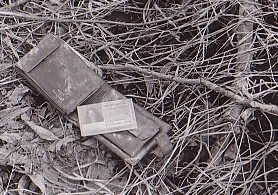 PHOTO FOURNIE PAR JOHN ALLORE Portefeuille de Theresa Allore, retrouvé à l’époque à plusieurs kilomètres de sa dépouille
PHOTO FOURNIE PAR JOHN ALLORE Portefeuille de Theresa Allore, retrouvé à l’époque à plusieurs kilomètres de sa dépouilleIl s’agit du corps de Theresa Allore, étudiante de 19 ans du collège Champlain, à Lennoxville, portée disparue plusieurs mois plus tôt.
Âgé d’à peine 14 ans à l’époque, John Allore a vécu avec cette impensable brisure toute sa vie. Il le raconte dans Wish You Were Here – A Murdered Girl, a Brother’s Quest and the Hunt for a Serial Killer, un récit d’indifférence policière à faire bouillir le sang, coécrit avec la journaliste et auteure canadienne Patricia Pearson.
 PHOTO FOURNIE PAR JOHN ALLORE Theresa Allore
PHOTO FOURNIE PAR JOHN ALLORE Theresa AlloreHeureuse et unie, sa famille n’a plus été la même après la disparition de Theresa, explique John Allore en entrevue téléphonique.
“C’est mon père qui a dû aller identifier le corps de Theresa à la morgue de la Sûreté du Québec, rue Parthenais, à Montréal. Il y est entré seul. Quand il en est ressorti, c’est comme si sa vie avait quitté son corps. Il n’a plus jamais été le même homme.”
John Allore
Les autorités indifférentes
L’élément qui interpelle dans Wish You Were Here est l’indifférence avec laquelle la direction du collège Champlain et la police locale ont traité la disparition inexpliquée de Theresa Allore, survenue un vendredi soir de novembre 1978 sur le campus de Compton.
Le collège Champlain, où elle était pensionnaire, s’est complètement désintéressé de sa disparition sous prétexte qu’elle avait eu lieu en dehors des murs de l’établissement. Élève douée et assidue, Theresa a vite été dépeinte comme une fille perdue, imprévisible et amatrice de drogue par les autorités locales.
 PHOTO FOURNIE PAR JOHN ALLORE John Allore et sa sœur Theresa
PHOTO FOURNIE PAR JOHN ALLORE John Allore et sa sœur TheresaSi bien qu’après la disparition, la famille Allore a été laissée à elle-même. « Ça rendait mes parents fous. Ils ne comprenaient pas pourquoi ni la police ni l’école ne s’intéressaient à Theresa. Un ami de ma sœur qui avait appris la nouvelle de sa disparition est arrivé pour aider et a dit qu’il s’attendait à voir des hélicoptères dans le ciel. Mais il n’y avait rien. Mon père faisait du porte-à-porte avec une photo de ma sœur parce que la police refusait de le faire. »
Même après la découverte du corps, les enquêteurs de la SQ ont estimé que Theresa avait sans doute fait une surdose et que des élèves paniqués avaient transporté son corps dans les bois – bien qu’elle ait été retrouvée à un kilomètre du collège, et que l’autopsie n’ait révélé la présence d’aucune drogue dans son organisme.
La SQ préoccupée par un autre enlèvement
À l’époque, la Sûreté du Québec était préoccupée par l’enlèvement de Charles Marion, directeur du crédit à la Caisse populaire Desjardins de Sherbrooke-Est, qui monopolisait l’attention médiatique dans la province, note John Allore, qui est aussi l’auteur de la balado émission Who Killed Theresa? et du blogue du même nom qui porte sur les meurtres non résolus de jeunes femmes au Québec.
« Je crois que tout le monde défendait ses arrières et évitait d’assumer la responsabilité. La SQ s’intéressait aux “vraies choses” : le crime organisé, les Hells Angels, les trafiquants de drogue… Une jeune femme qui se fait tuer près de Sherbrooke ? Et après ? »
“Les femmes à qui je raconte cette histoire se mettent tout de suite en colère, parce que c’est tellement évident pour elles. Elles subissent des violences sexuelles depuis toujours.”
John Allore
En faisant des recherches au début des années 2000, John Allore a réalisé que deux autres victimes, Louise Camirand, 20 ans, et Manon Dubé, 10 ans, avaient été retrouvées sans vie dans des boisés de la région en 1977 et 1978.
John Allore a aussi constaté qu’entre 10 et 15 femmes avaient rapporté des tentatives d’enlèvement à cette époque de la part d’un homme assez petit, avec une coupe de cheveux en bol et une moustache noire, qui conduisait une voiture en mauvais état dont la portière côté passager avait été modifiée afin qu’elle ne puisse pas s’ouvrir de l’intérieur. Plusieurs victimes parlaient aussi de ses mains, qui étaient grosses et extrêmement puissantes.
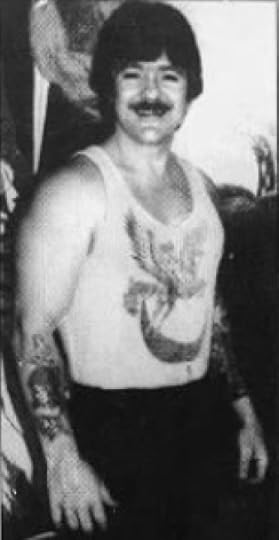 PHOTO FOURNIE PAR JOHN ALLORE Luc Grégoire, reconnu coupable de l’enlèvement et du meurtre en mai 1993 de Lailanie Silva
PHOTO FOURNIE PAR JOHN ALLORE Luc Grégoire, reconnu coupable de l’enlèvement et du meurtre en mai 1993 de Lailanie SilvaCet homme, Luc Grégoire, a plus tard déménagé à Edmonton puis à Calgary, où il a été reconnu coupable d’un vol à main armée, puis de l’enlèvement et du meurtre en mai 1993 de Lailanie Silva, une jeune femme de 21 ans qu’il avait agressée sexuellement et étranglée avant d’abandonner son corps dans un terrain vague.
Après l’arrestation de Grégoire, les enquêteurs ont trouvé dans son appartement une boîte à souliers qui contenait des bijoux bon marché, comme en portent des jeunes filles.
La propriétaire du logement avait demandé si les enquêteurs allaient se pencher sur les bijoux et s’était fait répondre que Grégoire s’en allait en prison à vie de toute façon, et qu’il ne fallait pas s’en faire.
“Dans le cas de Theresa, ses boucles d’oreilles, sa montre et ses bagues ont été retrouvées, mais pas son collier. On peut se demander s’il était dans cette boîte. C’est une question sans réponse.”
John Allore
John Allore a fait analyser les données des meurtres de Theresa Allore, Louise Camirand et Manon Dubé par un criminologue reconnu, selon qui ces meurtres sexuels sont si inhabituels que tout semble indiquer qu’ils auraient pu être commis par la même personne.
John Allore croit que Luc Grégoire, mort en prison en 2015, est peut-être l’auteur du meurtre de sa sœur, de même que de ceux de quatre autres jeunes femmes au Québec et deux autres en Alberta.
Après environ 20 ans à s’intéresser au meurtre impuni de sa sœur, John Allore veut maintenant trouver d’autres sujets à fouiller. « Il y a toujours une forme d’exploitation quand on raconte l’histoire d’une victime, dit-il. J’en suis conscient. Je l’ai longtemps fait dans le but de faire avancer l’enquête, mais maintenant je trouve ça plus difficile. Je crois qu’il est temps pour moi de faire une pause. »
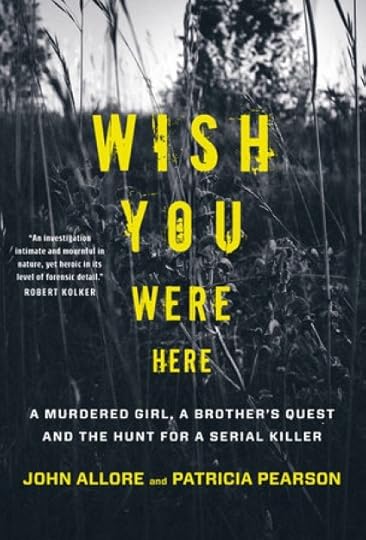 IMAGE FOURNIE PAR JOHN ALLORE Wish You Were Here – A Murdered Girl, a Brother’s Quest and the Hunt for a Serial Killer, de John Allore et Patricia Pearson
IMAGE FOURNIE PAR JOHN ALLORE Wish You Were Here – A Murdered Girl, a Brother’s Quest and the Hunt for a Serial Killer, de John Allore et Patricia PearsonThe post La quête d’une vie après un meurtre impuni first appeared on WHO KILLED THERESA?.
December 30, 2020
Who Were These Men / The Yorkshire Ripper – WKT4 #18
The Yorkshire Ripper
This is a crossover podcast episode. You can listen to the second half with Chantelle over at her podcast Lady Justice:
https://www.podchaser.com/podcasts/lady-justice-true-crime-936814
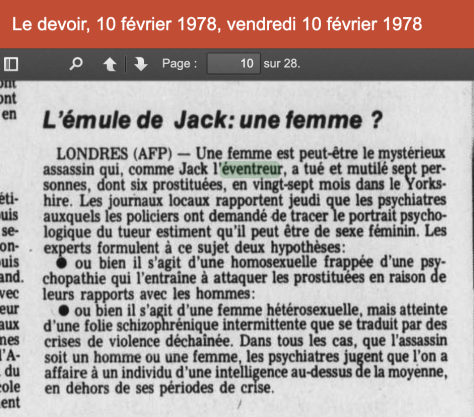 Agence France-Presse – Jack l’eventeur – 10 fevrier 1978
Agence France-Presse – Jack l’eventeur – 10 fevrier 1978“LONDON (AFP) – A woman may be the mysterious assassin who, like Jack the Ripper, killed and maimed seven people, including six prostitutes, in twenty-seven months in Yorkshire. Local newspapers reported on Thursday that psychiatrists asked to paint a psychological portrait of the killer believe he may be female. The experts formulate two hypotheses on this subject:
Either it is a homosexual struck by a psychopathy which causes him to attack the prostitutes because of their relations with the men.
Or it is a heterosexual woman, suffering from intermittent schizophrenic insanity that results in outbursts of unleashed violence.
Either way, whether the murderer is a man or a woman, psychiatrists judge that we are dealing with an individual of above average intelligence, outside of their times of crisis.”
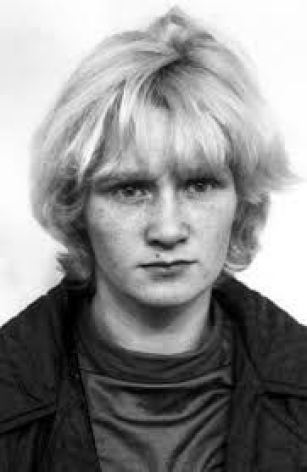 Wilma McCann
Wilma McCann Rebecca Boutilier
Rebecca Boutilier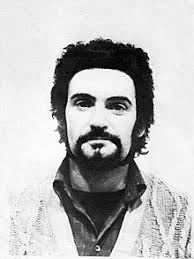 Peter Sutcliffe
Peter Sutcliffe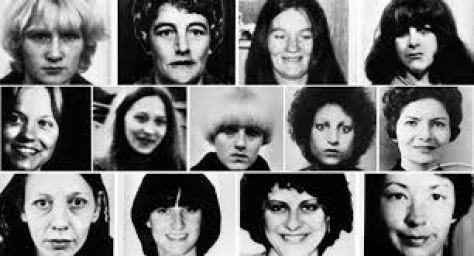 The 13 known murder victims
The 13 known murder victims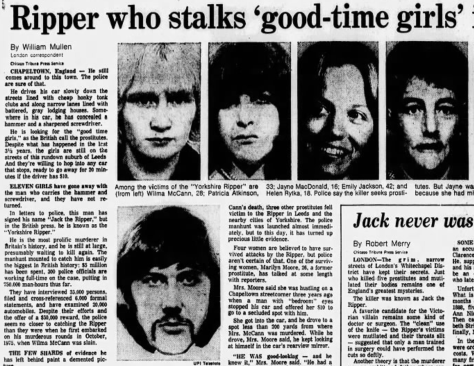 Ripper who stalks ‘good-time girls’
Ripper who stalks ‘good-time girls’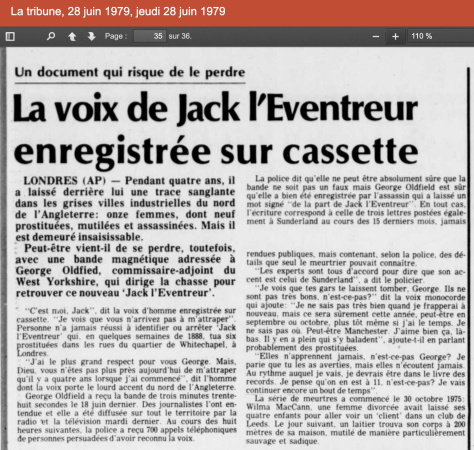 First Ripper story in Sherbrooke’s La Tribune newspaper ten weeks after Theresa Allore’s body is found on April 13th, 1979
First Ripper story in Sherbrooke’s La Tribune newspaper ten weeks after Theresa Allore’s body is found on April 13th, 1979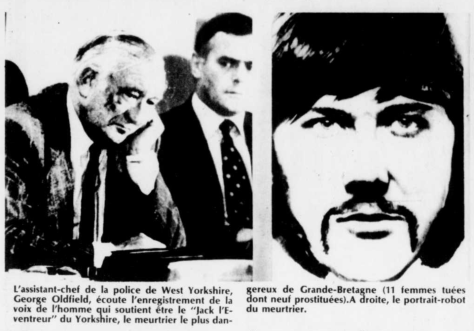
The Take Back The Night marches
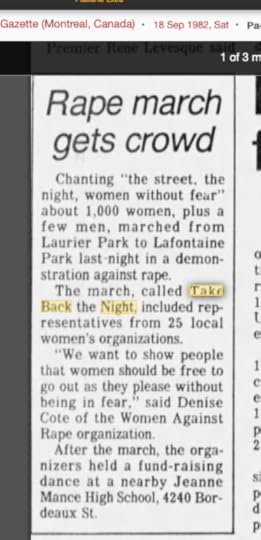 1982 Montreal Take Back The Night march
1982 Montreal Take Back The Night march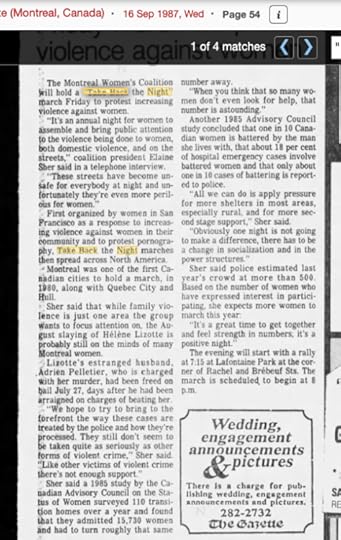 Montreal 1987 Take Back The Night march
Montreal 1987 Take Back The Night march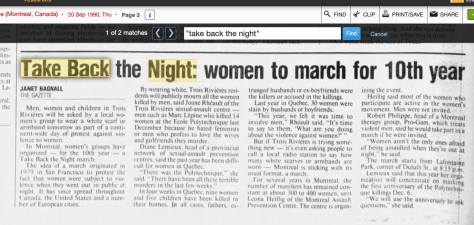 10th anniversary march with emphasis on the 14 mass murder victims at Ecole Polytachnique
10th anniversary march with emphasis on the 14 mass murder victims at Ecole Polytachnique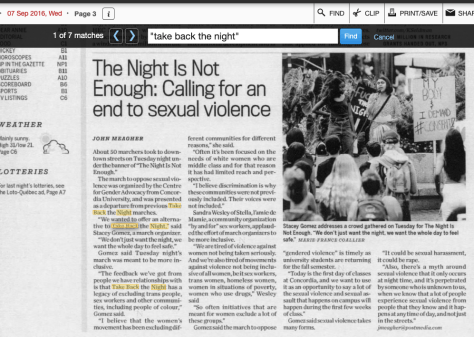 By 2016 the marches evolved into The Night Is Not EnoughThe post Who Were These Men / The Yorkshire Ripper – WKT4 #18 first appeared on WHO KILLED THERESA?.
By 2016 the marches evolved into The Night Is Not EnoughThe post Who Were These Men / The Yorkshire Ripper – WKT4 #18 first appeared on WHO KILLED THERESA?.
December 20, 2020
Sign In Stranger – WKT4 #17
Do you have a dark spot on your past?
Sign In Stranger
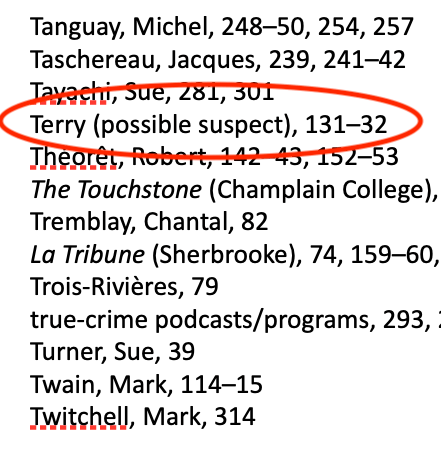
The post Sign In Stranger - WKT4 #17 first appeared on WHO KILLED THERESA?.



